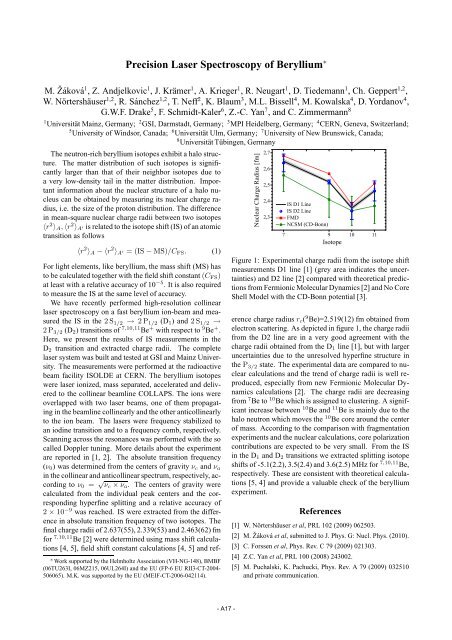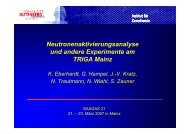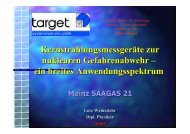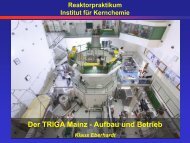institut für kernchemie universität mainz jahresbericht 2009
institut für kernchemie universität mainz jahresbericht 2009
institut für kernchemie universität mainz jahresbericht 2009
Create successful ePaper yourself
Turn your PDF publications into a flip-book with our unique Google optimized e-Paper software.
Precision Laser Spectroscopy of Beryllium ∗<br />
M. ˇZáková 1 , Z. Andjelkovic 1 , J. Krämer 1 , A. Krieger 1 , R. Neugart 1 , D. Tiedemann 1 , Ch. Geppert 1,2 ,<br />
W. Nörtershäuser 1,2 , R. Sánchez 1,2 , T. Neff 2 , K. Blaum 3 , M.L. Bissell 4 , M. Kowalska 4 , D. Yordanov 4 ,<br />
G.W.F. Drake 5 , F. Schmidt-Kaler 6 , Z.-C. Yan 7 , and C. Zimmermann 8<br />
1 2 3 4 Universität Mainz, Germany; GSI, Darmstadt, Germany; MPI Heidelberg, Germany; CERN, Geneva, Switzerland;<br />
5 6 7 University of Windsor, Canada; Universität Ulm, Germany; University of New Brunswick, Canada;<br />
8Universität Tübingen, Germany<br />
The neutron-rich beryllium isotopes exhibit a halo structure.<br />
The matter distribution of such isotopes is significantly<br />
larger than that of their neighbor isotopes due to<br />
a very low-density tail in the matter distribution. Important<br />
information about the nuclear structure of a halo nucleus<br />
can be obtained by measuring its nuclear charge radius,<br />
i.e. the size of the proton distribution. The difference<br />
in mean-square nuclear charge radii between two isotopes<br />
〈r2 〉A, 〈r2 〉A ′ is related to the isotope shift (IS) of an atomic<br />
transition as follows<br />
〈r 2 〉A − 〈r 2 〉A ′ = (IS − MS)/CFS. (1)<br />
For light elements, like beryllium, the mass shift (MS) has<br />
to be calculated together with the field shift constant (CFS)<br />
at least with a relative accuracy of 10 −5 . It is also required<br />
to measure the IS at the same level of accuracy.<br />
We have recently performed high-resolution collinear<br />
laser spectroscopy on a fast beryllium ion-beam and measured<br />
the IS in the 2 S 1/2 → 2 P 1/2 (D1) and 2 S 1/2 →<br />
2 P 3/2 (D2) transitions of 7,10,11 Be + with respect to 9 Be + .<br />
Here, we present the results of IS measurements in the<br />
D2 transition and extracted charge radii. The complete<br />
laser system was built and tested at GSI and Mainz University.<br />
The measurements were performed at the radioactive<br />
beam facility ISOLDE at CERN. The beryllium isotopes<br />
were laser ionized, mass separated, accelerated and delivered<br />
to the collinear beamline COLLAPS. The ions were<br />
overlapped with two laser beams, one of them propagating<br />
in the beamline collinearly and the other anticollinearly<br />
to the ion beam. The lasers were frequency stabilized to<br />
an iodine transition and to a frequency comb, respectively.<br />
Scanning across the resonances was performed with the so<br />
called Doppler tuning. More details about the experiment<br />
are reported in [1, 2]. The absolute transition frequency<br />
(ν0) was determined from the centers of gravity νc and νa<br />
in the collinear and anticollinear spectrum, respectively, according<br />
to ν0 = √ νc × νa. The centers of gravity were<br />
calculated from the individual peak centers and the corresponding<br />
hyperfine splitting and a relative accuracy of<br />
2 × 10 −9 was reached. IS were extracted from the difference<br />
in absolute transition frequency of two isotopes. The<br />
final charge radii of 2.637(55), 2.339(53) and 2.463(62) fm<br />
for 7,10,11 Be [2] were determined using mass shift calculations<br />
[4, 5], field shift constant calculations [4, 5] and ref-<br />
∗ Work supported by the Helmholtz Association (VH-NG-148), BMBF<br />
(06TU263I, 06MZ215, 06UL264I) and the EU (FP-6 EU RII3-CT-2004-<br />
506065). M.K. was supported by the EU (MEIF-CT-2006-042114).<br />
��������������������������<br />
���<br />
���<br />
���<br />
���<br />
���<br />
�����������<br />
�����������<br />
�����<br />
���������������<br />
�<br />
� � �� ��<br />
�������<br />
Figure 1: Experimental charge radii from the isotope shift<br />
measurements D1 line [1] (grey area indicates the uncertainties)<br />
and D2 line [2] compared with theoretical predictions<br />
from Fermionic Molecular Dynamics [2] and No Core<br />
Shell Model with the CD-Bonn potential [3].<br />
erence charge radius rc( 9 Be)=2.519(12) fm obtained from<br />
electron scattering. As depicted in figure 1, the charge radii<br />
from the D2 line are in a very good agreement with the<br />
charge radii obtained from the D1 line [1], but with larger<br />
uncertainties due to the unresolved hyperfine structure in<br />
the P 3/2 state. The experimental data are compared to nuclear<br />
calculations and the trend of charge radii is well reproduced,<br />
especially from new Fermionic Molecular Dynamics<br />
calculations [2]. The charge radii are decreasing<br />
from 7 Be to 10 Be which is assigned to clustering. A significant<br />
increase between 10 Be and 11 Be is mainly due to the<br />
halo neutron which moves the 10 Be core around the center<br />
of mass. According to the comparison with fragmentation<br />
experiments and the nuclear calculations, core polarization<br />
contributions are expected to be very small. From the IS<br />
in the D1 and D2 transitions we extracted splitting isotope<br />
shifts of -5.1(2.2), 3.5(2.4) and 3.6(2.5) MHz for 7,10,11 Be,<br />
respectively. These are consistent with theoretical calculations<br />
[5, 4] and provide a valuable check of the beryllium<br />
experiment.<br />
References<br />
[1] W. Nörtershäuser et al, PRL 102 (<strong>2009</strong>) 062503.<br />
[2] M. ˇZáková et al, submitted to J. Phys. G: Nucl. Phys. (2010).<br />
[3] C. Forssen et al, Phys. Rev. C 79 (<strong>2009</strong>) 021303.<br />
[4] Z.C. Yan et al, PRL 100 (2008) 243002.<br />
[5] M. Puchalski, K. Pachucki, Phys. Rev. A 79 (<strong>2009</strong>) 032510<br />
and private communication.<br />
�

















